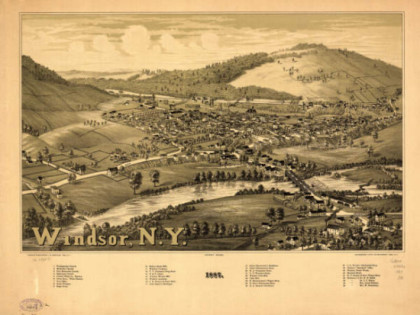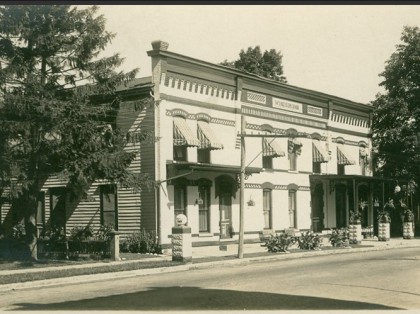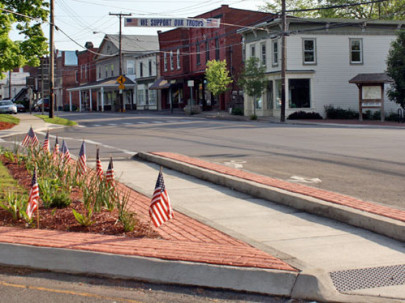History of Windsor NY
Pre-Windsor
“Windsor is one of the oldest, and, perhaps, the most historic town in Broome County,” says H.P. Smith in his 1885
publication “History of Broome County”. Created just one year after the formation of Broome County in 1806, Windsor was the largest town in the county and included the present-day towns of Colesville
and Sanford.
Hundreds of years before the first settlers arrived; this part of the Susquehanna River Valley was home to the Oneida and Tuscarora Indian. The largest and most permanent of their Iroquois
settlements was Oquaga, located in the shadows of the Ouaquaga Mountain, several miles north of the present-day Village of Windsor. New England missionaries worked among the Oquagans in the
mid-1700’s. Broome County’s first known white woman, Rebecca Kellogg Ashley, was an interpreter for Rev. Gideon Hawley and died here in 1757. A memorial marker honoring her burial site in North
Windsor was erected by the Daughters of the American Republic (DAR) in 1909.
Early Windsor
The earliest settlers came into the valley in 1788. John Doolittle was the first to arrive near Ouaquaga, followed soon after
by David Hotchkiss, who took up a large tract of land to the south. Many of the early pioneers had been soldiers in the War of Independence, and most of them came from Connecticut. The first
settlements were in the Susquehanna Valley, but by 1795 the hardy pioneers were taking up lands in the creek valleys and even on the hilltops.
Thanks to an abundance of natural resources, the number of new settlers grew dramatically, so that by 1808 there were almost 2,000 people in Windsor. The old growth forests of the valley provided
lumber that contributed significantly to the prosperity of the community. In 1835 fifteen sawmills were cutting their way through myriads of felled logs in the valley.
The early center of the town was in Ouaquaga, but by 1831 it was replaced by a site to the south, laying the foundation of Windsor village. Elias Whitmore opened up a large tract of land for
development and he and George Dusenberry brought the business interests to Windsor. David Hotchkiss founded Windsor Village and gave the community its village green; the only one in all of Broome
County.
19th Century
The Town of Windsor continued to prosper throughout the 19th century. Bartering of both goods and services was the way most
people did business in Windsor back then. The cultivation of farming quickly developed on the bare hillsides and in the valleys and grew. Dairying was particularly suitable for the terrain and was a
major industry in the town until well into the 20th century. The construction of a branch line by the D&H Railroad in 1872 from Susquehanna, Pa., to Nineveh brought a new era of prosperity to
Windsor as it became much easier to ship dairy and agriculture products, lumber, and Windsor’s world famous whips.
Whipmaking
For nearly a century starting in the 1850’s, whip making held a prominent place in Windsor. Adin Coburn, a shoemaker, was the
first to make whips of all kinds in the town in 1855. The Coburn Whip Factory, a major employer in the Village for many years, became a nationally known company with offices in New York City and San
Francisco. Windsor was also home to the Empire State Whip Company, C.M. Comstock Whip Company, and the Windsor Whip Company, which was the last one to close its door in 1948.
Railroad
The coming of passenger trains to the valley at the turn of the century brought tourists to Windsor, transported by coach from
the depot to one of the Village’s fine hotels. The railroad in Windsor continued to prosper until the end of World War II, but by the mid 1970’s it ceased to exist. As long-time local historian
Charles English wrote in 1997 for the Village Centennial, “The vacant depot and portions of the railroad bed lie as silent reminders of a more glorious period of time that has passed
by.”
20th Century and Today
The 20th century brought many changes to the town. In education, the 26 school districts—mostly one-room schoolhouses—were
consolidated. Windsor had prided itself in being an educational center in the latter 1800’s, with well-attended teacher training classes at the Windsor Academy in the village. With consolidation, a
new brick building for kindergarten through 12th grade was constructed at the north end of the village and opened in 1933. Today, it is jointly occupied by Alice Freeman Palmer Elementary students
and the Windsor Middle School.
Like other rural communities in the last century, Windsor saw many of its people begin to work outside of the town. By 1936,
renovations to Route 17 and the increasing use of autos for transportation opened up employment opportunities in Binghamton and beyond. By the latter part of the 1900’s, local businesses were in
decline and agriculture was no longer a driving force in the town’s economy.
Today, Windsor is beginning a new chapter in its long history. Capitalizing on the natural beauty of the town and its quaint
village setting, efforts are being made to rediscover the vitality that once defined this oldest town in Broome County.
Submitted by Eileen Ruggieri
Contact Us Today!
Windsor Partners Inc.
P.O. Box 432
Windsor NY, 13865
Email: Contact@WindsorPartners.org
Current officers are:
Click on a name to access their email.




